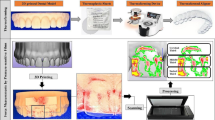Abstract
Objective:
The aim of the present study was to determine the surface hardness of light- and auto-cured resins for the fabrication of occlusal splints employing Vickers hardness measurements.
Materials and Method:
In this study we used three auto-polymerized resins (Palapress®, Orthocryl®, Steady-Resin® M) and four light-polymerized resins (Acrylight®, Primosplint®, Triad® Tran- Sheet® Colorless and Triad® TranSheet® Pink). The Vickers hardness measurement was carried out by means of a universal Durimet indenter applying a test load of 50 g for 30 seconds. The light-cured resins were polymerized in a Tagris® Power light oven for 10 and 15 minutes each. Three separate test series were carried out (the hardness of plates under optimal conditions and of occlusal splints was measured, and the curing of light-polymerizing materials in layers of varying depth was evaluated). Data underwent statistical analysis via ANOVA and the Scheffé test.
Results:
The microhardness determined in each case amounted to values between 10.4 HV 0.5 and 39.3 HV 0.5. The Vickers hardness determined for the plates that had been produced under optimal conditions demonstrated that their surface was significantly (p < 0.05) harder than that of cylinders and splints. The hardness values of the light-cured material Triad® TranSheet® Pink (39.3 HV 0.5) were significantly higher (p < 0.05) than those of all other resins. In all auto-polymerized resins, the surface hardness of the samples we examined (in the form of plates and splints) was significantly lower (p < 0.05) than that of the light-cured materials Triad® TranSheet® Pink and Colorless.
Conclusion:
The results we have obtained so far concerning surface hardness indicate that, in the fabrication of occlusal splints, light-cured resins may represent an alternative to auto-polymerizing materials.
Zusammenfassung
Ziel:
In der vorliegenden Studie sollte mit Hilfe von Vickers-Härtemessungen die Oberflächenhärte von Licht- und Autopolymerisaten für die Herstellung okklusaler Splinte ermittelt werden.
Material und Methode:
Es wurden drei Autopolymerisate (Palapress®, Orthocryl®, Steady-Resin® M) und vier Lichtpolymerisate (Acrylight®, Primosplint®, Triad® TranSheet® Colorless und Triad® TranSheet® Pink) verwendet. Für die Vickers-Härtemessung kam das Kleinlasthärteprüfgerät Durimet mit einer Prüflast von 50 g für 30 s zum Einsatz. Die Polymerisation der lichthärtenden Kunststoffe erfolgte im Lichtofen Tagris® Power für jeweils 10 und 15 Minuten. Drei verschiedene Versuchsreihen wurden durchgeführt (Härtemessung an Plättchen unter Idealbedingung, Härtemessung an okklusalen Splinten sowie Ermittlung der Durchhärtung der lichthärtenden Materialien in verschiedenen Schichttiefen). Es erfolgte eine statistische Auswertung der Daten nach dem ANOVA- und dem Scheffé-Test.
Ergebnisse:
Die ermittelten Mikrohärten für die Plättchen lagen zwischen 10,4 HV 0,5 und 39,3 HV 0,5. Die für die unter idealisierten Bedingung angefertigten Plättchen festgestellte Vickers-Härte ergab eine signifikant größere (p < 0,05) Oberflächenhärte als für Zylinder und Splinte. Die Härtewerte für das lichthärtende Material Triad® TranSheet® Pink (39,3 HV 0,5) waren signifikant (p < 0,05) höher als die aller anderen Kunststoffe. Die Oberflächenhärte der untersuchten Proben (in Form von Plättchen und Splinten) lag für alle Autopolymerisate signifikant (p < 0,05) unter jener der lichthärtenden Materialien Triad® TranSheet® Pink und Colorless.
Schlussfolgerung:
Die bisher gewonnenen Ergebnisse bezüglich der Oberflächenhärte deuten darauf hin, dass die lichthärtenden Kunststoffe bei der Herstellung okklusaler Splinte eine Alternative zu den autopolymerisierenden Kunststoffen darstellen können.
Similar content being viewed by others
Author information
Authors and Affiliations
Corresponding author
Rights and permissions
About this article
Cite this article
Danesh, G., Lippold, C., Ziebura, T. et al. In-vitro Investigation on Suitability of Light-cured Resins for Interocclusal Splints. J Orofac Orthop 67, 138–147 (2006). https://doi.org/10.1007/s00056-006-5032-5
Received:
Accepted:
Issue Date:
DOI: https://doi.org/10.1007/s00056-006-5032-5




